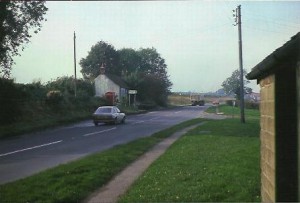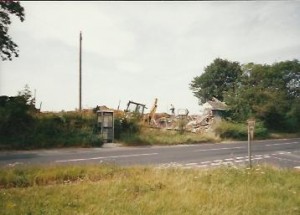Shown on the 1892-1893 map, the two cottages on the south side of the B1257 came into the possession of the Parish Meeting on an unknown date. Lime washed they too became known as White Cottages.
There is a story that a benefactor left the pair of cottages to the parish for the benefit of the poor.
It is known from the Parish minutes they faced demolition at least twice.
The sale of land for the widening and straightening of the B1257 gave the parish enough money to carry out repairs in the mid 1930s.
Condemned
By the end of the 1980s the cottages were once again condemned. With no assets to sell the Parish Meeting could afford neither repairs, nor demolition, so sold the uninhabitable cottages.
Parish minutes at the turn of the 19th/20th Centuries record the Parish renting one of the cottage out at £2-10s (two pounds and ten shillings) a year. But in 1902 it was agreed to reduce the rent down to £2 per year “the tenant doing his own repairs”.
Trouble was noted in 1906 when it was reported one of the occupants “had sold his furniture, little by little, till all was gone and that he had entered the workhouse as a pauper”. The Parish considered there was not the slightest chance of getting the rent due (£1) as the man was destitute. It was decided that “if ever he came out of the workhouse and obtained employment, action should be taken to recover the amount owning.” By May the Parish learnt its former tenant had found employment at North Grimston and Mr Warren (clerk) was “instructed to apply to him for the amount of rent £1 due to the Parish, failing payment to put the matter into court.”
In May 1906 a request for repairs to be done was turned down as “the rent was only a nominal sum” and the terms on which it was let had included repairs to be carried out by the tenant.
Repairs
In 1924 the Parish wanted the cottages vacating to carry out repairs. It was discovered a tenant had sub-let and was paying all the rent and rates direct to the district council. It was decided to refer the issue to the clerk of the Rural District Council. The other tenant wrote to say it would be very inconvenient as his wife was practically an invalid; however he wished to thank the ratepayers for their kindness.
The Parish Meeting decided all applications for tenancies would become void. A committee was appointed to inspect the cottages with members given the power to act over any repairs. A month later the cottages were vacant and a new tenant agreed a rent of £5 4s 0d per year with the tenant paying all the rates and taxes.
The other tenancy attracted four offers and was let at £7 16s 0d per year, again the tenant paying all the rates and taxes.
Rents were paid half yearly to one of the overseers and it was agreed to pay the rents as they fell due over to the repairer of the cottages. This carried on until at least 1929. Then in1933 it was noted a lot of banking had fallen in affecting a wash-house. The cottages “were down for demolition”.
Saved from demolition
But they were saved by the sale of land to the North Riding Council for road widening; £6 19s 6d raised from the sale to be spent on repairs. The Parish heard the cottages were before the Public Health Committee of the Rural District Council. It was decided to rescind the demolition order as the Parish gave an undertaking to repair in accordance with the specifications of the Sanitary Officer and the Medical Officer of Health.
Getting estimates for the repairs was difficult, with the only one received being for £30 for one cottage and £25 for the other. As the meeting was “greatly surprised at the very low figure” the tender was accepted unanimously. However a roof was later found to be “about falling in” and the estimate was revised to a total of about £70. The rents were increased by 6d per cottage.
But in 1938 it “was decided to delay any repairs to the cottages for the present owing to the unrest in the country.” By 1940 it was a case of waiting to see what building materials were available. By the end of the year it was agreed to go ahead.
In 1960 Parish Chairman Arthur Ford was given powers to act as landlord for the cottages. This involved paying all accounts as they became due. Despite repairs carried out over the years in 1962 Mr Ford told the parish one of the cottages “could be used for anything except human habitation.”
Subsequently only one of the cottages was let.
In 1970 the Parish was asked to lay on a water supply, the cost to be equally shared between the parish and the local Lions club amounting to £9.82p each.
In 1976 a new tenancy was agreed at £1 per week (£52 a year). One month’s free rent was agreed in exchange for the tenant offering to keep the bus shelter clean. But in 1987 the front wall of the unoccupied cottage partly collapsed.
Sale of site
Initially an estimate was sought to demolish the derelict cottage while making the habitable cottage safe. But in May 1988 it was decided it was in such a dangerous condition that the tenant should be rehoused after Menzies Bros (Builders) advised demolition of both cottages.
The cost was beyond the Parish Meeting. Instead in February 1989 outline planning permission for one dwelling was granted by Ryedale District Council. It was agreed to contact the Department of Environment for permission to sell the plot. Legal advice was sought from local solicitor the late Mr John Atkinson with G A Property Services used to value the site and conduct the sale of the plot by private treaty.
Three offers were received and on June 19th 1989 an agreement was signed for the sale of the cottages to Mr Andrew Menzies. Although there seems to be no legal documents showing how the cottages came into the possession of the Parish Meeting, there is a completion document (PDF, 307k) relating to their sale.
By the end of 1990 the parish had over £26,000. Broughton Parish Meeting was asked by Swinton District Playing Field Association for financial assistance towards the development of land as a playing field. This to serve the parishes of Amotherby, Swinton and Broughton, ie Broughton, Swinton and Amotherby Sports Hall and Playing Fields.
At a meeting attended by 16 Broughton residents in Swinton Reading Room, it was agreed to give a donation of £3,000 and to loan £10,000 interest-free for 5 years if needed, thereafter at an interest rate to be decided by both parties. In 1999 the Association began repayments to the Parish Meeting of £500 annually. No interest was ever charged. A television was bought for the Hall; donations given to the Swinton Short Mat Bowling Club and the Swinton and Broughton Cricket Club towards equipment.
The Parish also purchased 12 new street lights (£2,277.00), for which grant covered 30% of cost. Later £1,000 was contributed towards the purchase price of land to form a new burial ground for the parishes of Amotherby, Swinton and Broughton. There was also a the donation of £2,000 towards the upgrading of the Swinton Reading Rooms, used for the Playgroup, table tennis, snooker and a polling station for Broughton residents.
The rest of the monies were used over the years to cover parish costs, of which the largest annual cost was electricity for the 14 street lamps.
It was not until 2010 that the Parish Meeting decided that from April 2011 it needed to set a precept to raise £2,500.
Information taken from the parish minutes can be viewed at Parish Minutes 20thC.
AGW 2011


Speak Your Mind